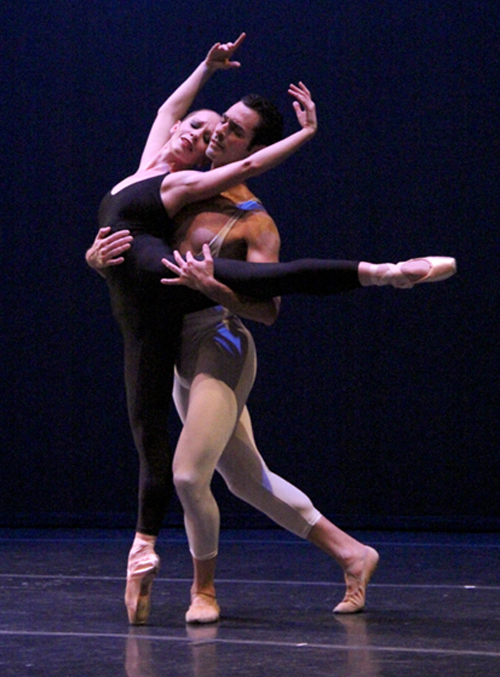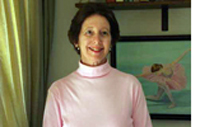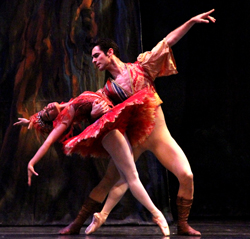
By Sheila Orysiek

SAN DIEGO — One of the pleasures of attending the Nov. 6 performance of City Ballet of San Diego is the continuity of taste and purpose which has guided and built the Company. A few years ago a decision was made to make the Spreckels – a gem of a classic theater – the Company’s home; thus it began to grow confident roots. Though challenged by turbulent economic times, a decision was made to use live music whenever possible; thus a credible orchestra has evolved under the leadership of John Nettles. Artistic Director Steven Wistrich and Resident Choreographer Elizabeth Rowe Wistrich supply the taste and vision. Dancers are challenged by change, but they also grow with a steady vision to guide them.
“HCIV-OKAT-SOHS” (Shostakovitch spelled backwards) was a good choice to open the Company’s 2011-2012 season. Wistrich’s choreography to Piano Concerto No. 2 gave twelve dancers a quirky but cohesive ballet. The dancers were clad in solid white or black leotards and tights giving a unitard effect – all against a black backdrop. The dancing was certainly nicely done – everyone on time and in place – but it needed to be a bit crisper around the edges. However,
just when I was about to say “ho hum” – the mood changed entirely.
The dancers exited leaving only Ariana Samuelsson and Geoff Gonzalez on stage. What followed was one of the most exquisite pas de deux I’ve had the pleasure to see in a very long time. It was not in the mold of a grand Russian pas de deux such as Sleeping Beauty or the weeping pas deux of a Swan Lake. Nor was it one of the countless neo-pseudo modern pas de deux in which the principal purpose seems to be to test the elasticity of the ballerina. There was none of the grappling which often tries to pass for passion, no forced angst, no “together but still alone” and no contrived/contorted
choreography.
At times the dancers were at a distance from one another but they were always connected, they looked at one another, they cared about one another – and it was a reminder of the beauty of the ballet with which many of us fell in love years ago. Brava/bravo to both Samuelsson and Gonzalez – thank you for the reminder.
“Rococo Variations” (Tchaikovsky’s Variations on a Rococo Theme for Cello/Orchestra Op33), had the dancers in red leotard tops with short tunic skirts for the women, black trunks for the men. This is a bright work with nine sections featuring various numbers of dancers. Most noteworthy is the unified work of the men and the graceful arms in the women.
However, amongst the women there needs to be a consensus on the height of the arabesque leg (even when it is only 45 degrees) in chasse relevé to pointe. And, the one dancer’s occasional little preparatory (habit forming) hop just before launching into pique tours en dedans – needs to go.
“Tchaikovsky Pas de Deux” is part of the Company’s Balanchine repertoire. Ariana Samuelsson and Gerardo Gil danced this pas de deux with all the grand manner of the Russian genre. While Balanchine was known for his vision of moving dance into the future – he was also a product of the Russian ballet in all its grandeur and he could tap into that at will. Samuelsson easily gives a full picture of that style with panache. Her fouetté enchainement was not only well done but also performed to the left which is something I can’t recall ever seeing before.
It was a distinct pleasure to see the exponential growth of Gil. He was a prince – clean, caring – grand.

“The Firebird” usually alternates between Stravinsky’s blazing score for the Firebird and the Monsters with the lullaby music for the Princesses. Wistrich cut a bit here, changed a bit there and thus the ballet clicked together. Dancing “Firebird” Erica Alvarado, new to the Company, displayed a rock sure technique and an understanding of the role. She is a petite lady who easily fills her space but must now fill the stage – she has to possess it. Size is no barrier – many, many of those tiny (by modern standards) famous Russian prima ballerinas filled that huge Bolshoi stage. I have always prized the advice that Frederick Ashton gave to Margot Fonteyn: “linger a while.” When Alvarado snaps into a confident – beautiful – arabesque just before exiting – hold it a moment
longer. Let us enjoy it. Allow it to permeate to the farthest seat in the house. I look forward to seeing more of this dancer.
The monster scene is time for the men of the Company to have some fun – go for it – be the monster of our nightmares. Ballet is structured but it is that structure which gives freedom. Scare me more.
This fulsome program is a most promising start to the season with new dancers to watch and hopefully more treats to come. Kudos to pianist Nina Flowers, Cellist Caitlin Fahey and members of the orchestra.
*
Orysiek, a freelance writer based in San Diego, is a former ballet performer and teacher. She may be contacted at sheila.orysiek@sdjewishworld.com